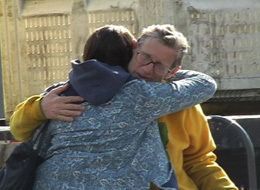
In August of 2003, I started filming homeless people all around Los Angeles.
Four years later my experience became my first feature film, a personal documentary, called WITHOUT A HOME.
I was twenty-three years old when I began and I had no idea what I was doing. I was listening to a voice that had been in my head for as long as I could remember, following an unexplainable connection to the homeless that I had felt since childhood. I was drawn into their world, and that was enough.
Having recently graduated from film school, I took out a loan on a video camera and hit the streets of my native Los Angeles -- in search of any homeless person who would talk to me.
It was just me setting out on this adventure alone. No crew, no protection!
I created some ground rules for myself which would effectively minimize the degree of danger I was potentially subjecting myself to: Always approach people without my camera first, never shoot at night and always stay in a populated area where people can see me. But by the time I was shooting my third mini DV tape (of what was later to become over 185 hours of footage) I found myself throwing away my silly rules.
And soon enough there I was, hopping a fence in North Hollywood, camera in hand. My new friend Joby, drunk and high, led me down a path alongside the 134 Freeway towards a makeshift tent of silky red tarp that he called home.
My heart raced with nervous excitement as I treaded through the unpaved path to see where he lived. With each step I took, visions of being raped, stabbed and left for dead beside the freeway danced in my head.
But despite common sense and the neurotic voice of my Jewish mother booming emphatically in my mind, I followed my instincts and, in doing so, I was following my heart -- for a hopeless romantic there are worse ways to die.
Neuroses aside, it felt wonderful and liberating to put my faith and even my safety in the hands of these strangers. I spoke to so many people, all with different stories and reasons for how they ended up on the street and it was such an extraordinary, humbling and educational experience for me. I learned of their challenges and setbacks, felt their heartache as if it were my own and realized, as I suspected, that their dreams were not unlike mine.
For the first time, this abstract and profound connection that initially pulled me into their world, became both more palpable and also more concrete.
Despite the sea of differences which separated me from them, it was our shared humanity that took my breath away and touched the deepest part of my soul.
I felt driven to use my camera and the interviews I was compiling as a tool to bridge the gap between the ordinary world I was living in and the one I was visiting each weekend. I wanted to reveal this intricate, dark, beautiful and mysterious web of humanity to the world, not only to show how the other half lives, but as a reminder that in fact they do live.
As time progressed and I got deeper into filming, the people I met were no longer strangers but were becoming my friends. And they were asking me for help. How could I say no? I felt an enormous amount of compassion and love for these people and I wanted to help them however I could. Despite the profound complexity of their problems, I discovered that there were simple things I could do to help.
I made phone calls on their behalf, bought them sketch-books to draw in, drove them places too far to walk and I listened to their incredible stories all the while filming and documenting the experience, which had become just as much mine as theirs.
In time, these good deeds became far more complicated and I soon found myself intertwined in their lives in ways I never would have imagined. Whether I was helping Gilbert bypass the nearly impenetrable bureaucracy in getting him admitted into a detox program for heroin addiction, or offering Aric a ride to his storage facility to collect his winter clothes; for me, the spirit of the intention was the same: I will help you because I care and because I can.
More profound than any action one takes, more charitable than any good deed performed, is the humanity and compassion that lies within us and prompts us to act. There are approximately 90,000 homeless people in Los Angeles, and for the most part they live outside the normal conventions, mores and rules of our society. To see and treat them as a friend and as a human being, instead of a statistic or another body cluttering the sidewalk, is the most powerful thing I believe we can do.
Whether or not you have the time, the means or the desire to inquire about someone's story, or what item of clothing they need to make it through a chilly winter, you can always ask yourself, "How would I treat them if they were a long lost friend or a neighbor in need?" That is how I have come to see homeless people.
WITHOUT A HOME Trailer from Rachel Fleischer on Vimeo.
It has now been nearly 5 years since I began my filming the homeless of Los Angeles. I am in no way an expert, but I have seen firsthand the power we all have as individuals to affect real change not only in their lives, but in our own.